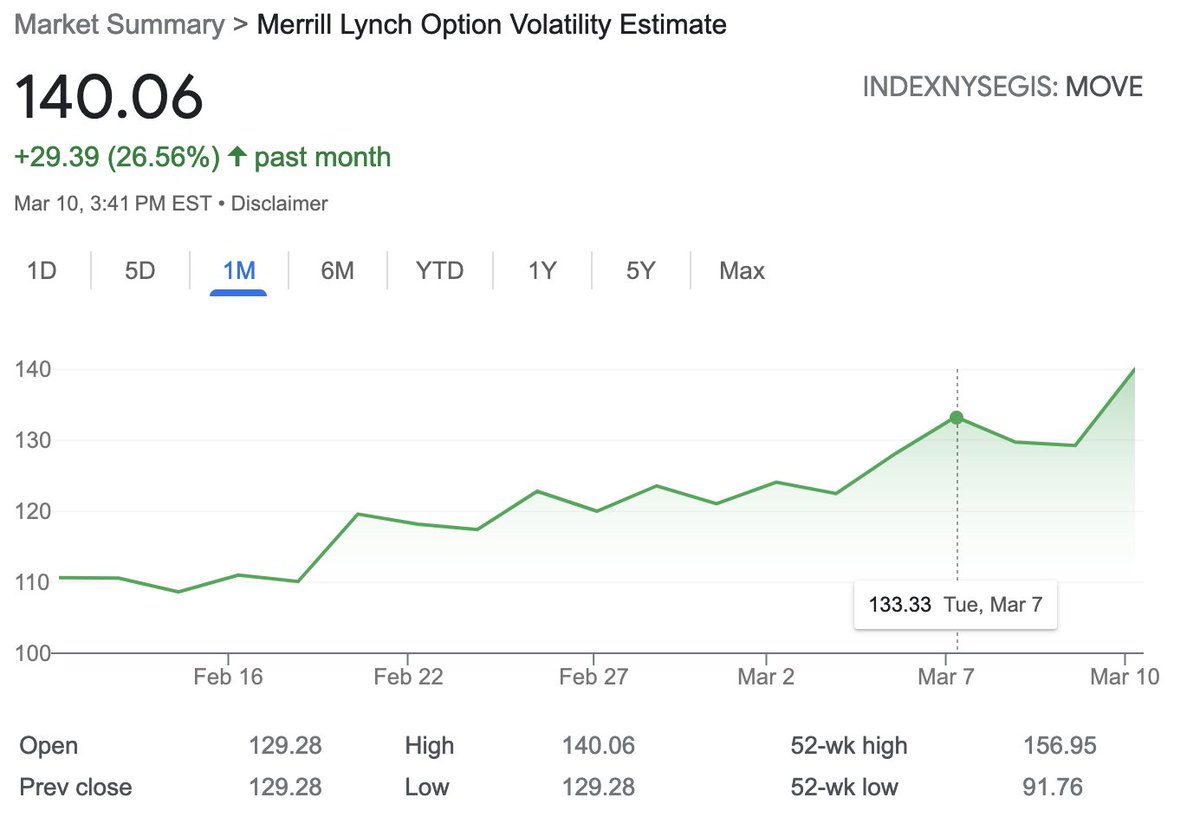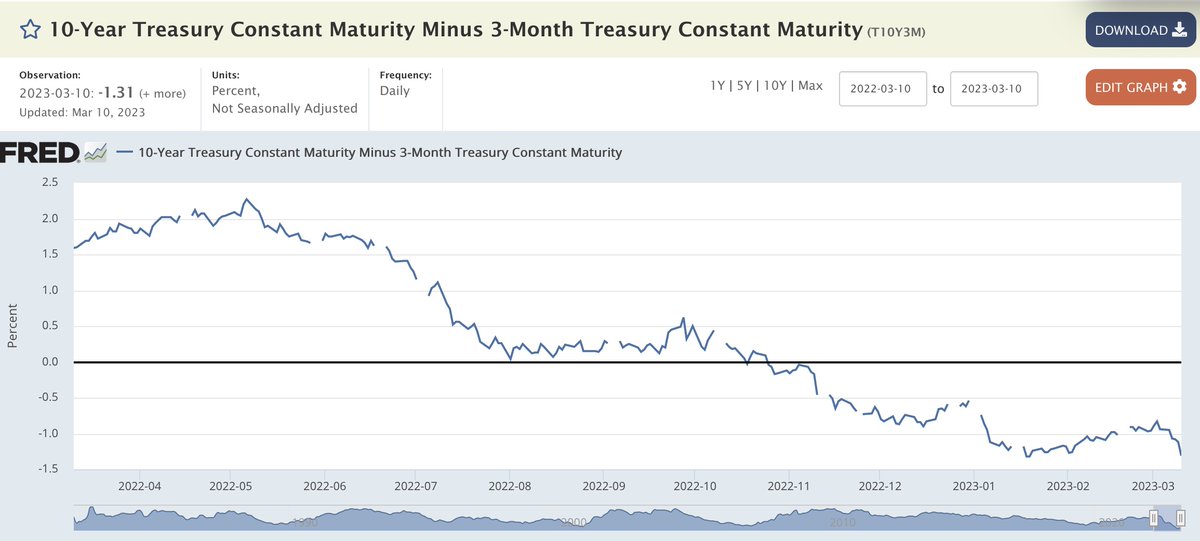🐻♉️↗️↘️↔️⚠️🚩🔺🔻💰
Macro Review 03/10/23
🧵 1/8
The #Kraken may have been unleashed on financial markets this week with volatility up across asset classes.
Let’s dig into the critical 🧮 from the week!
© Adobe Stock
Macro Review 03/10/23
🧵 1/8
The #Kraken may have been unleashed on financial markets this week with volatility up across asset classes.
Let’s dig into the critical 🧮 from the week!
© Adobe Stock

2a/8
After a week of reflation and my #CrashRiskRising call from 02/26/23, Jay Powell stepped up to the plate and told us “dot plot going higher.”
The UST2Y ripped, the curve inverted further, and the MOVE ↗️
Chart: MOVE index 140.06
After a week of reflation and my #CrashRiskRising call from 02/26/23, Jay Powell stepped up to the plate and told us “dot plot going higher.”
The UST2Y ripped, the curve inverted further, and the MOVE ↗️
Chart: MOVE index 140.06

2b/8
After two days of Powell chatting with Congress, the UST 2Y accelerated to 5.05%, a multi-year high, before crashing hard on the SVB news.
Chart: $UST2Y with -1.6 STD move in 2 days
After two days of Powell chatting with Congress, the UST 2Y accelerated to 5.05%, a multi-year high, before crashing hard on the SVB news.
Chart: $UST2Y with -1.6 STD move in 2 days

2c/8
By the end of the week, the 10Y3M curve re-inverted to a a cycle low of -131 bps
“It’s nothing, bro.” It’s priced in. You can't make money with a consensus view by buying bonds because you think a recession is coming.
Yup, this time is different. ✅
Chart: 10Y3M
By the end of the week, the 10Y3M curve re-inverted to a a cycle low of -131 bps
“It’s nothing, bro.” It’s priced in. You can't make money with a consensus view by buying bonds because you think a recession is coming.
Yup, this time is different. ✅
Chart: 10Y3M

2d/8
By the end of the week, long bonds were ripping on the SVB news.
You see - the freaking MOVE and the inverted yield curve were telling you something. #Kraken
Chart: TLT daily +3.46% in a single day
By the end of the week, long bonds were ripping on the SVB news.
You see - the freaking MOVE and the inverted yield curve were telling you something. #Kraken
Chart: TLT daily +3.46% in a single day

3a/8
And then we have equities.
Mike Wilson, the highly respected MS CIO who had maintained a consistently bearish outlook, capitulated on Monday, March 6
And then we have equities.
Mike Wilson, the highly respected MS CIO who had maintained a consistently bearish outlook, capitulated on Monday, March 6
https://twitter.com/tdarling1/status/1632914359209934850?s=20
3b/8
The $VIX hit a low of 18.14 the same day Mike capitulated; it steadied, rose on Powell, and ripped on SVB
Chart: $VIX daily closed at 24.80 after tagging 28.97 intraday on Friday. #Kraken
The $VIX hit a low of 18.14 the same day Mike capitulated; it steadied, rose on Powell, and ripped on SVB
Chart: $VIX daily closed at 24.80 after tagging 28.97 intraday on Friday. #Kraken

3d/8
The $SPX put in a big higher low at 4078 the very day Mike capitulated, before 🤮
Chart: $SPX daily shed -4.7% in 4 days #Kraken
The $SPX put in a big higher low at 4078 the very day Mike capitulated, before 🤮
Chart: $SPX daily shed -4.7% in 4 days #Kraken

3e/8
Small caps starting selling on Monday and never looked back
Chart: $IWM daily -8.0% on the week #Kraken
Small caps starting selling on Monday and never looked back
Chart: $IWM daily -8.0% on the week #Kraken

4/8
#NFP came out relatively hot on Friday +311,000 with wages +4.6% y/y, but it didn’t matter as it was quickly subsumed by SVB, the 15th largest bank in the US, imploded to FDIC receivership
Chart: US Average Hourly Earnings #AHE ticked up to +4.6%
#NFP came out relatively hot on Friday +311,000 with wages +4.6% y/y, but it didn’t matter as it was quickly subsumed by SVB, the 15th largest bank in the US, imploded to FDIC receivership
Chart: US Average Hourly Earnings #AHE ticked up to +4.6%

5/8
On any other day, the $USD would have ripped higher as +50 BPS became fully priced into the 3/22 #FOMC meeting. But SVB called that all into question as the Fed may be forced to ease rather than tighten to avoid a banking #Kraken
On any other day, the $USD would have ripped higher as +50 BPS became fully priced into the 3/22 #FOMC meeting. But SVB called that all into question as the Fed may be forced to ease rather than tighten to avoid a banking #Kraken

6/8
GOLD, on the other hand, benefited from the drop in yields and the USD as well as the underlying concern about more bank runs.
Chart: $GOLD, after putting in a short-term double bottom at 1813, climbed +2.7% in 2 days
Kryptonite for the #Kraken
GOLD, on the other hand, benefited from the drop in yields and the USD as well as the underlying concern about more bank runs.
Chart: $GOLD, after putting in a short-term double bottom at 1813, climbed +2.7% in 2 days
Kryptonite for the #Kraken

7a/8
Was it Powell? Was it SVB?
Doesn’t matter - our concern could quickly shift from sticky #inflation to outright deflation if more banks are forced to realize losses by selling their “pristine” reserves, notably USTs and MBS. #Kraken
Was it Powell? Was it SVB?
Doesn’t matter - our concern could quickly shift from sticky #inflation to outright deflation if more banks are forced to realize losses by selling their “pristine” reserves, notably USTs and MBS. #Kraken
7b/8
Banks have been complacent for too long with free deposits.
Investors have discovered money markets yielding 4.5% and T-bills at 5%
Depositors pull deposits, and banks are forced to realize losses on collateral, setting up a self-reinforcing downward spiral #Kraken
Banks have been complacent for too long with free deposits.
Investors have discovered money markets yielding 4.5% and T-bills at 5%
Depositors pull deposits, and banks are forced to realize losses on collateral, setting up a self-reinforcing downward spiral #Kraken
8/8
Crash risk is no longer rising.
It is right in front of us.
Next week will be telling and complex with a HUGE March #OPEX on Friday, Uncle Carl ITM, and big risks to the down side
Avoid the #Kraken and have a super profitable 💰 week!
Crash risk is no longer rising.
It is right in front of us.
Next week will be telling and complex with a HUGE March #OPEX on Friday, Uncle Carl ITM, and big risks to the down side
Avoid the #Kraken and have a super profitable 💰 week!
• • •
Missing some Tweet in this thread? You can try to
force a refresh










